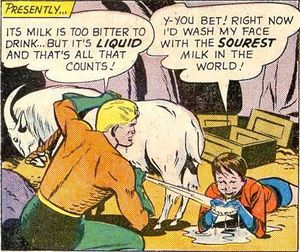Comic
The comic, also known as sequential art, is a popular contemporary art form that is considered distinct from, but closely related to both visual arts and literature.
The comic uses sequences of pictures (in two-dimensional layout), called panels, to narrate a story. The panels are usually drawn in cartoon style and also include text in various forms: captions, balloons for speech, thought balloons for thoughts and sound effects.
Comics typically tell fiction, although there are also some examples of non-fiction comics. Some of the most successful comic characters are Funny Animals, anthropomorphic creatures which behave and interact like humans (eg Mickey Mouse, Bugs Bunny, Woody Woodpecker). The practice of attributing human characteristics to talking animals can be traced back at least as far as Aesop's Fables.
Types and genres
The shortest comics are called comic strips. Strips typically narrate a fictitional humorous anectdote (using devices such as puns) in only 3 or 4 panels, or in a single page at most. Longer sequences are found in comic books. The longest stories, the comics equivalent to a novel or novella, are called graphic novels.
Comics come in all kinds of genres: from Disney's "Duckville" universe to superhero comics, from science fiction to erotic adult comics.
Comic creation
The art of comic ceation is closely related to the art of motion picture creation. The author will typically first write a script, describe and design the characters that appear in the story, decide on the sequence of scenes, dialogues, captions, etc, and finally on technical details such as the format and angle of view (e.g. close-up, long shot) of individual panels.
In professional comic ceation, the individual phases of the work are often distributed in a team of specialists. A typical workflow may look like this: One person (or team) writes and finalizes the script, which is given to the publisher for approval. Once the script is approved, an artist (or team of artists), the so-called pencillers, draws the pages in pencil. Then another artist (or team), the so-called inkers, inks, cleans up and finalizes the lineart. The last steps are adding text, colorization if required, and anything else that needs to be done before it goes to print.
Manga
In Japan, the comic has evolved in its own distinct style, called manga. Japanese comics are much more popular in Japan than western comics are in western countries. From a commercial point of view, manga are one of the most successful print products.
See also
Chat rooms • What links here • Copyright info • Contact information • Category:Root
